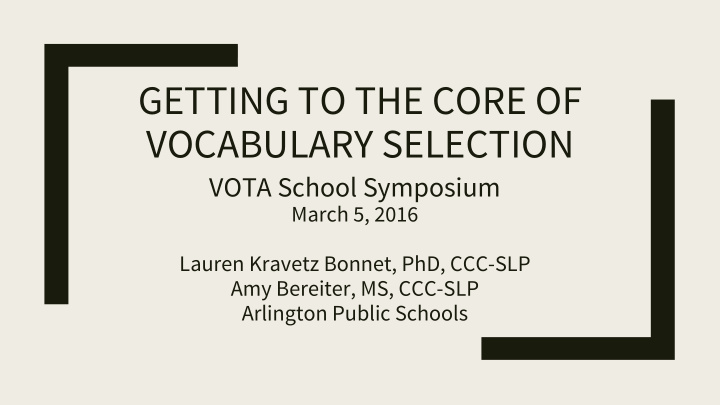



GETTING TO THE CORE OF VOCABULARY SELECTION VOTA School Symposium March 5, 2016 Lauren Kravetz Bonnet, PhD, CCC-SLP Amy Bereiter, MS, CCC-SLP Arlington Public Schools
Why are we here? ■ Interprofessional education (IPE) = “instruction that transcends siloed, discipline-specific methodologies by emphasizing learning alongside and from members of other disciplines” (Barr, et al. 2005) ■ primary objective = improved practice and patient/client care ■ “Continuing education would seem to be a viable means for established service providers to pursue IPE.” (Ogletree 2005) Barr, H., Koppel, L., Reeves, S., Hammick, M., & Freeth, D. (2005). Effective interprofessional education: Assumption, argument and evidence . London, England: Blackwell. Ogletree, B., (2015). Meeting complex communicaiton needs associated with genetic syndromes: A call to interprofessional education and practice. SIG 12 Perspcwtice on Augemtnaice and Alternative Communication, 24, 67-73.doi:10.1044/aac24.3.67
Objectives 1. Define core vocabulary and discuss importance related to AAC users 2. List several key research studies to support use of core 3. Identify considerations for selecting vocabulary in an AAC system 4. Differentiate between core word based and context based communication systems Make an application to a student currently on your caseload!
If you could only have 15 words… … what would they be?
How should SLPs approach vocab selection in AAC? ■ Lang development ■ What we know about disorder/dx ■ Language treatment ■ Long distance view ■ Are we putting things in place that fulfill four communicative purposes? (Light, 1989) ■ Schools: do they have vocab available that allows them to demonstrate their knowledge? To meet the SOLs? obtain literacy? ■ Presume competence! Light, J., (1989). Towards a definition of communicative competence for individuals using augmentative and alternative communication systems. Augmentative and Alternative Communication, 5, 137-144.
WHAT IS CORE VOCABULARY? ■ =80% of what we say – About 350-400 words ■ CORE VOCABULARY is a statistical concept related to overall word frequency ■ CORE VOCAB is consistent across clinical populations, activities, places, topics, and demographic groups ■ CORE VOCAB contains few picture producers ■ * don’t confuse this with CCSS
Fringe Vocabulary ■ The other 20% of what we say – Labels, nouns, low frequency words, context specific – Should not have page after page of fringe when it makes up only 20% of what we say – examples of throw away words ■ When IS it necessary? – Choices, activity row, personal fringe (e.g. family names, preferred items)
Research ■ Banajee, DiCarlo, Stricklin (2003) ■ Marvin, Beukelman, Bilyeu (1994) ■ Balandin, Iacono (1999) ■ Howes (1966) ■ Stuart, Beukelman, King (1997) ■ VanTatenhove (2005) ■ Cannon (2009) ■ Witkowski and Baker (2012) ■ a host of others!
So, core… ■ Supports communication across environments ■ Puts building blocks for generative language (spontaneous novel utterances) and meeting SOLs in place – “ ALMOST ALL OF OUR SENTENCES ARE NOVEL.” - Chomski
So we want to choose/provide vocab that can be used… In multiple contexts • For multiple meanings • For teaching language • For generation of language •
Group Activity ■ Use the fringe board ■ Use the core board
Make a board
Context based versus core word based ■ Context based (fringe vocab) vs. Core word based AAC
Diagnosis how does this affect implementation? presentation of materials? plan?
Let’s revisit your 15 word board ■ Would you change it? ■ What would you change?
Applications to your caseload
Questions and Discussion
Thank you! Lauren.bonnet@apsva.us Amy.bereiter@apsva.us
Recommend
More recommend